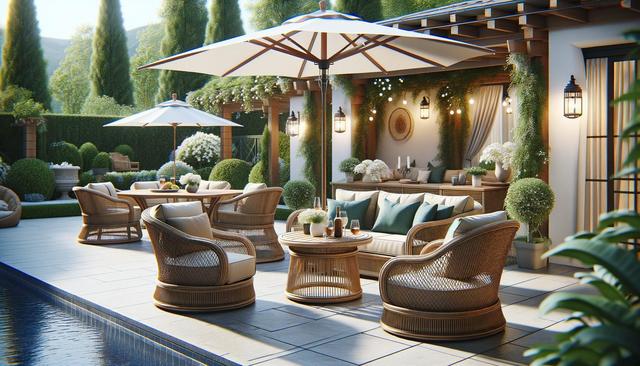Transforming Outdoor Spaces with Functional and Stylish Patio Furniture
Creating a comfortable and inviting outdoor space starts with the right patio furniture.

Understanding the Role of Patio Furniture in Outdoor Design
Patio furniture is more than just a place to sit—it’s a key element in shaping the aesthetic and functionality of any outdoor area. Whether it’s a backyard, balcony, or garden, the right furniture can turn an empty space into a vibrant extension of your home. It provides a setting where people can relax, entertain, or dine alfresco, making outdoor living more enjoyable and practical. When selecting patio furniture, it’s essential to consider how the space will be used. Is it for quiet evenings with family, hosting weekend barbecues, or lounging with a book? Your lifestyle should guide your furniture choices to ensure the space meets your needs.
Outdoor furniture must also withstand various weather conditions. Material selection plays a vital role in longevity and usability. Common options include metal, wood, plastic, and rattan, each offering unique benefits in terms of durability, maintenance, and visual appeal. Additionally, many homeowners opt for modular furniture sets that can be rearranged, allowing for greater flexibility and adaptability throughout the seasons.
Choosing the Right Materials for Durability and Comfort
When it comes to patio furniture, material selection is critical. The goal is to find a balance between comfort, style, and outdoor resilience. Some materials are better suited for particular climates or levels of maintenance. Here’s a breakdown of popular patio furniture materials:
- Teak wood: Known for its natural oils that resist moisture and insects, making it ideal for long-term outdoor use.
- Aluminum: Lightweight, rust-resistant, and easy to clean. Perfect for areas with high humidity or salt air.
- Resin wicker: Offers a classic look with better resistance to the elements than natural rattan.
- Plastic or polymer: Budget-friendly and available in various colors, though less durable than other options.
Cushions and fabrics also play a role in comfort and aesthetics. Look for weather-resistant textiles such as solution-dyed acrylics, which resist fading, moisture, and mildew. Removable and washable cushion covers are also a practical feature to consider, especially in areas with variable weather patterns.
Maximizing Functionality with Multi-Purpose Pieces
Limited space doesn’t mean you have to sacrifice comfort or style. Multi-functional patio furniture can help you make the most of your outdoor area without overcrowding it. These pieces are designed to serve more than one purpose, saving space while enhancing utility.
- Storage benches: Combine seating with hidden compartments for storing cushions or garden tools.
- Convertible tables: Adjustable height tables that transition from coffee tables to dining tables.
- Modular sectionals: Rearrangeable to fit any layout, offering flexibility for different occasions.
- Ottomans with storage: Useful as footrests, extra seating, or for storing outdoor essentials.
By incorporating these versatile pieces, you can adapt your space for different functions—morning coffee, evening drinks, or family meals—without needing to invest in multiple furniture sets. This approach also simplifies seasonal storage and maintenance, making your patio more manageable year-round.
Adding Personality with Accessories and Layout
While the core of patio furniture lies in seating and tables, accessories add character and comfort to the space. These elements help tie the design together and can be easily updated to refresh the look from season to season. Consider integrating the following accessories into your patio:
- Outdoor rugs: Define seating areas and add texture and color underfoot.
- Pillows and throws: Bring warmth and personalization through patterns and fabrics.
- Lighting: String lights, lanterns, and solar-powered lamps extend usability into the evening.
- Planters: Add greenery and vertical interest, softening hard surfaces and enhancing ambiance.
When arranging patio furniture, think in terms of zones—dining, lounging, and activity areas. This helps create a more organized and inviting layout. Leave enough space for movement between areas, and consider the flow from indoors to outdoors. A well-placed bench or loveseat can serve as a transition piece, making the outdoor space feel like a natural extension of your home.
Care and Maintenance Tips to Extend Longevity
Proper maintenance can significantly extend the life of your patio furniture, keeping it looking fresh and functional for years. The amount of care required depends largely on the materials used. Here are some general maintenance tips:
- Clean regularly: Use mild soap and water to remove dirt and prevent mold buildup.
- Protect during off-seasons: Use furniture covers or store items indoors during harsh weather.
- Reapply finishes: Wood furniture may need periodic sealing or oiling to maintain its appearance.
- Inspect hardware: Tighten bolts and check for rust or corrosion on metal parts.
Fabrics and cushions should be stored in a dry place or brought indoors when not in use to prevent mildew. Some furniture pieces also benefit from touch-up paint or UV protectant sprays to reduce sun damage. By investing a little time in care, you enhance both the usability and visual appeal of your patio furniture over time.